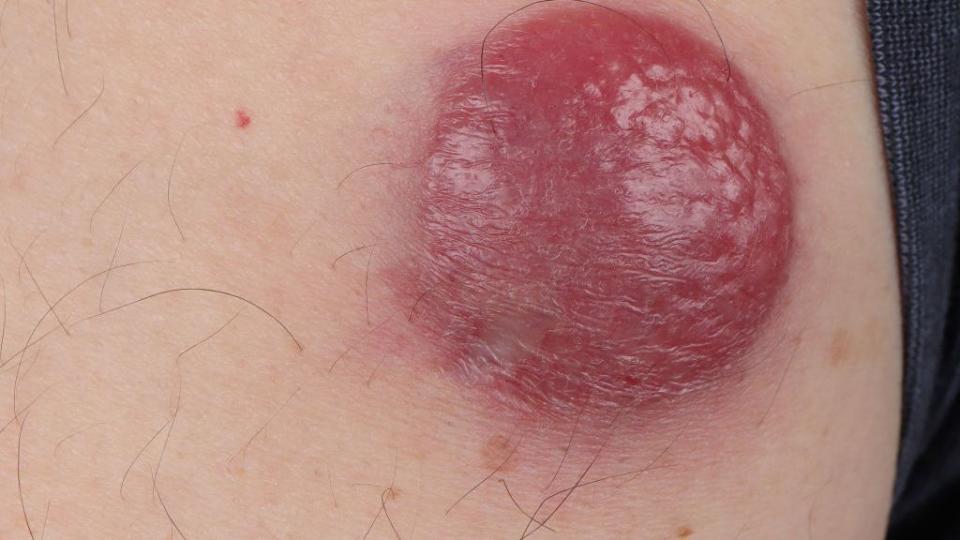What You Need to Know About Merkel Cell Carcinoma, the Skin Cancer Jimmy Buffett Had

- Oops!Something went wrong.Please try again later.
“Margaritaville” singer Jimmy Buffet died of Merkel cell carcinoma on Sept. 1.
Merkel cell carcinoma is a rare and aggressive form of skin cancer.
Experts stress the importance of early detection.
Jimmy Buffett fans were shocked late last week when news broke that the iconic “Margaritaville” singer died of Merkel cell carcinoma, a form of skin cancer that he was diagnosed with four years ago. “He continued to perform during treatment, playing his last show, a surprise appearance in Rhode Island, in early July,” a statement on his website read.
According to a statement released on Instagram, the 76-year-old “passed away peacefully,” surrounded by his family, friends, music, and dogs. “He lived his life like a song till the very last breath and will be missed beyond measure by so many,” the post said.
Buffet’s death has raised a lot of questions about Merkel cell carcinoma, including what it is and how it’s treated. Here’s what you need to know.
What is Merkel cell carcinoma?
Merkel cell carcinoma (also known as Merkel cell skin cancer) is a rare type of cancer where malignant cells form in the skin, according to the National Cancer Institute (NCI).
Merkel cells are found in the top layer of the skin, and are very close to the nerve endings that receive the sensation of touch, the NCI says. This form of cancer usually starts in areas of skin that are exposed to the sun, like the head and neck, as well as the arms, legs, and trunk.
“Merkel cell carcinoma is different from other skin cancers such as basal cell carcinoma or melanoma in several ways,” says Wael Harb, M.D., a medical oncologist at MemorialCare Cancer Institute at Orange Coast Medical Center in Fountain Valley, CA. “It is much rarer, more likely to spread quickly to other parts of the body—such as lymph nodes and organs—harder to treat, and more prone to come back after treatment.”
Board-certified dermatologist Ife J. Rodney, M.D., founding director of Eternal Dermatology Aesthetics, stresses that Merkel cell carcinoma is rare. “We don’t see it very often at all,” she says. “But it is very aggressive. A lot of times when we do diagnose it, it’s already spread to the lymph nodes or other organs.”
Symptoms of Merkel cell carcinoma
Merkel cell carcinoma usually shows up as a small bump on the skin, Dr. Rodney says.
“It is generally a small, non-pigmented growth on the skin that can look like a wart or a non-melanoma skin cancer like a basal or squamous cell carcinoma,” says Adam C. Berger, M.D., chief of Melanoma and Soft Tissue Surgical Oncology, associate director for Shared Resources at Rutgers Cancer Institute of New Jersey and a professor of surgery at Rutgers Robert Wood Johnson Medical School.
“These bumps are usually pinkish, skin-colored, reddish, or blue,” Dr. Rodney says. The key feature is that these bumps often change quickly, says Gary Goldenberg, M.D., a board-certified dermatologist practicing in New York City. “If you have a new bump...it’s not going away and it’s getting bigger, make sure to see your dermatologist right away,” he says.
Merkel cell carcinoma pictures
The appearance of Merkel cell carcinoma can vary. However, a bump may look like this:

How is Merkel cell carcinoma diagnosed and treated?
The first thing your dermatologist will do is biopsy the bump, Dr. Rodney says. “Because Merkel cell carcinomas are rare, chances are the bump won’t be one—but it’s better to be safe than sorry,” she says. “The chances for a positive outcome are much better when it’s caught early.”
If a biopsy shows that the bump is Merkel cell carcinoma, more tests will be needed to see if the cancer has spread and how far. “If caught early, it can be treated with surgical removal and sometimes followed by radiation therapy,” Dr. Berger says. “If it is more advanced and involves lymph nodes or other metastases, it is typically treated with immunotherapy.”
Merkel cell carcinoma survival rates
As with many forms of cancer, survival rates for Merkel cell carcinoma depend largely on when it’s detected. The American Cancer Society (ACS) breaks down the five-year survival rates for Merkel cell carcinoma:
Localized (meaning, the cancer hasn’t spread outside the skin where it started): 75%
Regional (the cancer has spread to nearby structures or lymph nodes): 61%
Distant (the cancer has spread to the lungs, liver, or distant parts of the body): 24%
Overall, the ACS noyrd that the survival rates for Merkel cell carcinoma in all stages is 65%. “The vast majority of patients recover from Merkel cell carcinoma and never have recurrence,” Dr. Berger says.
But again, early detection is crucial. “The best chance you have for a cure is early diagnosis,” Dr. Rodney says.
You Might Also Like

